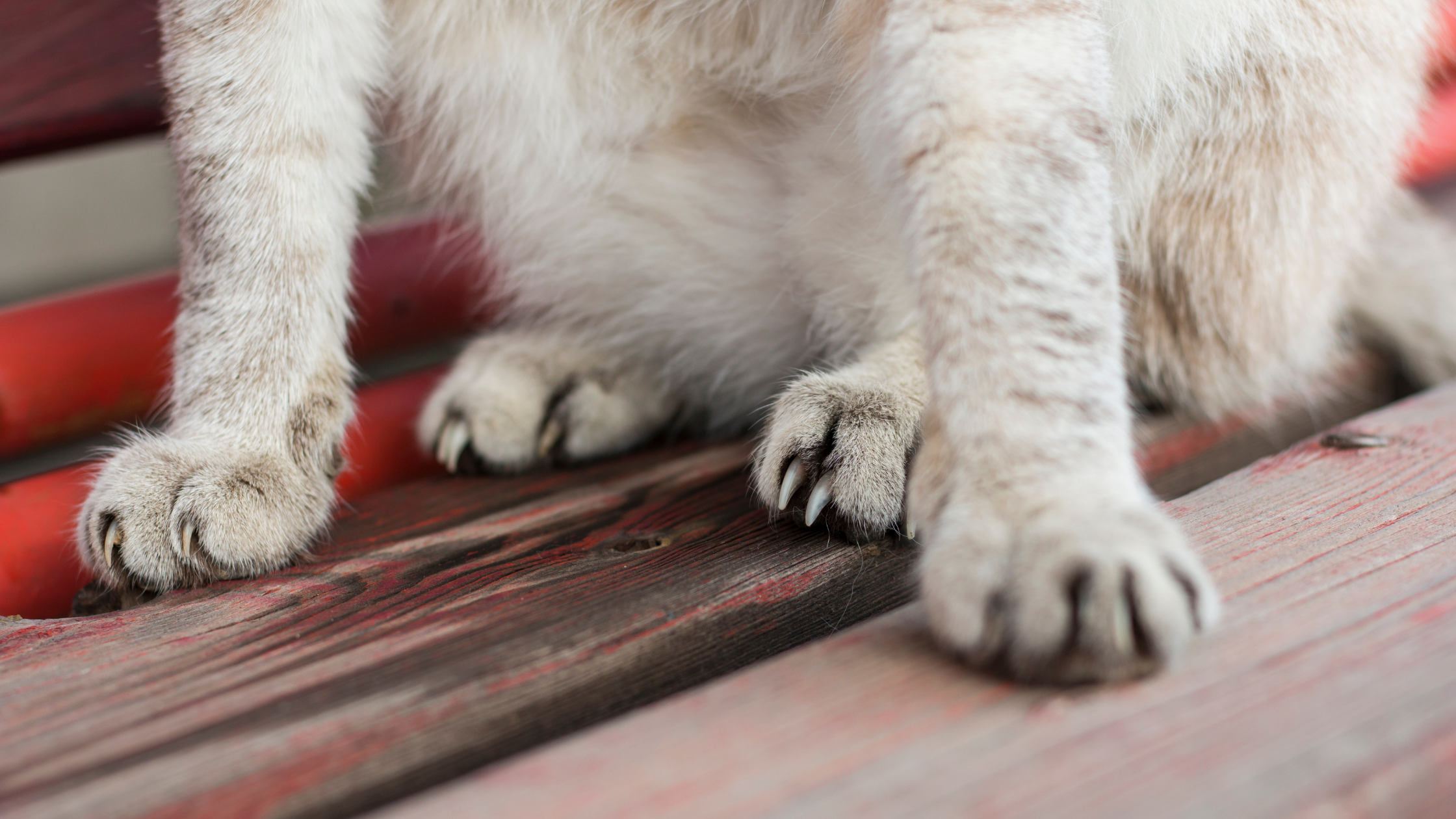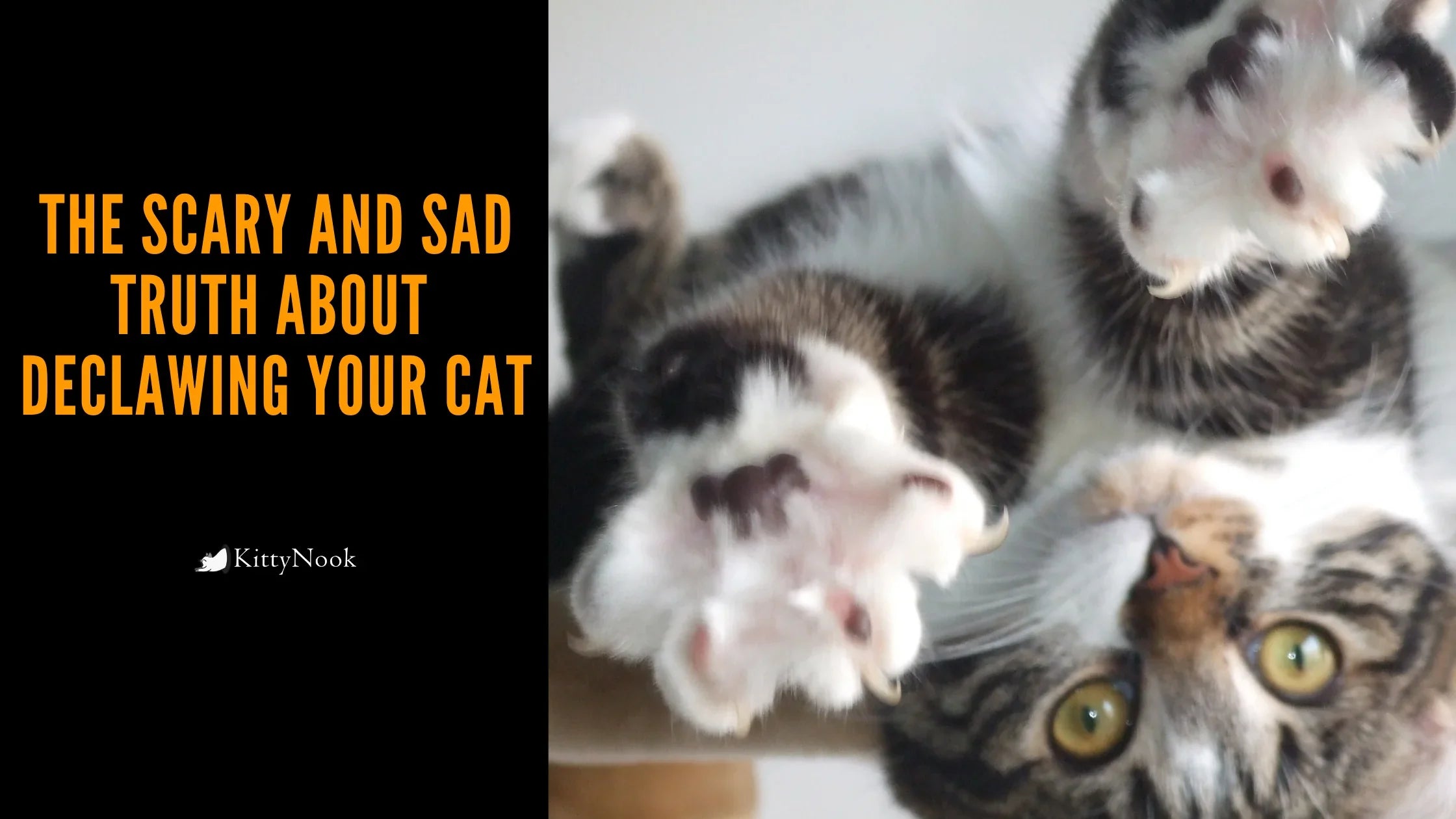Declawing your cat is not the solution to destructive scratching. Declawing is a needless, painful, and utterly crippling procedure that includes removing a cat's digits down to the first knuckle.

Imagine going to a beauty parlor and asking to have your nails cut, and the manicurist goes on to pull out an extensive set of clippers and cut your nail off at the knuckle. This is what happens when you declaw your cat.
Defined by Cats International, the term 'declawing' makes people believe that just the cat's claw is removed, but in truth, a more apt description would be amputation or mutilation.
Declawing fits the dictionary meaning of mutilation to a tee. Words such as deform, disfigure, disjoint, and sever all relate to this surgical procedure. It does not matter how the treatment is performed: scalpel, laser, or guillotine. The outcome is the same: excruciating pain. This is the brutal fact of declawing your cat.
This Is What A Cat Feels After Being Declawed
Motor nerves in the cat's paw pads are reduced, harmed, and ruined. And nerve damage is far from the only nasty outcome of this major surgery. Add the long-term side effects: recuperation from unnecessary surgery is a slow and highly uncomfortable process. The initial pain from declawing stays days after surgery; the chronic pain after the procedure is life-long, and the disappearance of natural feline activities. Your cat is also susceptible to wound infection post-surgery. All in all, this treatment keeps cats from enjoying things such as strolling, running, springing, climbing, and even stretching free of discomfort. This debilitating treatment keeps our felines from a life of fun, energetic normal cat activities.
How is Declawing Performed?

The most common type of declawing is called an onychectomy—it involves cutting the bones from which claws grow with either a scalpel or a guillotine clipper. Scalpel onychectomy is the most conventional approach to declawing, the injuries are closed with stitches or surgical glue, and the feet are bandaged.
Another technique is laser onychectomy, in which a small, high-intensity beam cuts through tissue by heating and evaporating it. However, it's still the amputation of the cat's last toe bone, and with it the same lasting effects such as lameness and behavioral issues as does declawing with scalpels or clippers.
A third procedure is called a tendonectomy, in which the ligament or tendon that controls the claw for each toe is severed. This procedure is connected with a high occurrence of abnormally thick claw emergence. The cat keeps their claws but can not control them to stretch nor to fulfill its natural scratching behavior. As a result, regular nail trims are required to stop the cat's claws from catching on people, carpet, furnishings, and drapes or growing into the cat's paw pads.
Due to the said issues, the cat that underwent tendonectomy may need an onychectomy later. Although a tendonectomy is not technically an amputation, a 1998 research study released in the Journal of the American Veterinary Medical Organization found that incidence of blood loss, lameness, and infection are similar between tendonectomy and declawing.
Why Do People Declaw Their Cats?

In extreme situations, surgery is medically needed, like a nasty infection in the nail bed or a tumor. However, many people declaw cats to stop them from unwanted scratching and damaging furnishings, which is an act of mutilation done to change feline behavior for mere convenience.
And while many European countries signed a treaty that forbids declawing as far back as the early 1990s, 55% of cat owners said it was okay to declaw their cats here in the US. Some studies even suggest that between 20%-25% of pet felines in the US have been declawed. By contrast, declawing was always uncommon in the UK, even before making it illegal in 2006.
What Can You Do Instead?

Instead of declawing your cat, try these reliable, gentler alternatives to surgery in dealing with unwanted scratching.
Trim your feline's nails regularly. Giving your cat regular nail trims is the easiest way to lessen unwanted scratching behavior. When the cat is relaxed, gently pinch the paws until the claws extend. Use a set of claw clippers, and clip only on the very ends of the nail as not to accidentally cut the blood vessel or "quick." The nail hook rips upholstery, so removing it eliminates the potential for cat scratching damage in the home. For more comprehensive instructions on how to trim your kitty's nails, you can read through this guide.
Provide access to scratching posts and other scratching surfaces. Preferably, you need to have two or even more scratching zones and acceptable scratching alternatives in the house. See that the cat scratching posts are solid and are big enough to enable your cat to stretch (3 feet or longer). Soft and fluffy carpeted surfaces won't meet your cat's clawing needs, so search for rougher posts such as this sisal scratching post. You can also DIY one yourself using sisal rope or sisal fabric.
Teach your feline where (and where not) to scratch. Urge your cat to utilize the scratching posts by spraying catnip on them. Discourage your cat from the furniture by using a loud, solid voice whenever they start unwanted scratching; cats don't like loud noises! Never physically discipline your cat. Instead, you could try using gentle water sprays loaded with warm water pointed at your cat's back.
Nail caps are also considered a more humane alternative to declawing, but even vinyl nail caps are still viewed as needless and cruel by many cat parents.
Are There Situations Where Declawing Should Be Allowed?

Many vet societies in the country are opposed to a total ban because they say declawing must be a "last resort" if the owner would indeed decide to desert their cat otherwise. Some pet owners do not like to have cats unless they are sure that the cat cannot damage the furnishings.
It appears that declawing cats are the product of owner satisfaction more than anything.
People worried about being scratched, particularly those with immunodeficiencies or hemorrhaging problems, might be misinformed that their health will be safeguarded by declawing their felines. But in truth, the risk for these people is lower compared to cat bites, cat litters, or fleas carried by their kittens.
Many individuals also think that declawed cats are safer around babies; however, the lack of claws makes cats feel so insecure that they tend to bite regularly as a way of self-protection.
Felines are in discomfort when they awake from the surgical procedure, and the misery continues months after surgery. Nails can also grow inside the paw, causing severe pain that you can't see.
Declawing has to be an outright last resort, but many people still declaw their felines for minor reasons. For example, some think cat feet look cuter and fluffier when declawed.
Are Things Changing?

They certainly seem to be. In July of 2019, New York became the first state in the US to make declawing illegal. In addition to this, specific cities such as Los Angeles and Denver have also outlawed declawing.
Humane Society of the Nature Coast has approved the surrender of felines that have undergone this brutal method, as well as not allowing any person who plans on having it declawed to adopt a cat.
Twenty years ago, this procedure was seriously considered something you do - you get a cat, you declaw them. Over the years, however, declawing has become an increasingly questionable procedure. Younger veterinarians appear to be more encouraging of a ban, specifically as modern studies seem to give evidence against declawing.
Like other issues, cat claws can be very politicized in the US. Things are generally moving towards anti-declawing sentiments, although it's not surprising that the one-state that moved towards outlawing the procedure is a liberal blue state. The cities banning it are commonly viewed as left-leaning.
Final Words: Don't Subject Your Feline to Unneeded Procedures

Declawing and tendonectomies should only be booked for those extreme cases in which a cat has a medical problem that would need such surgical procedure to save their lives, such as the need to remove cancerous nail bed tumors. And not as a quick fix for unwanted scratching.





















